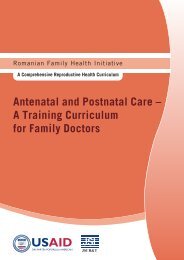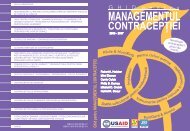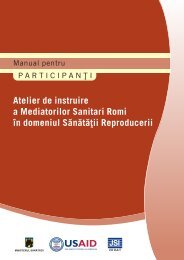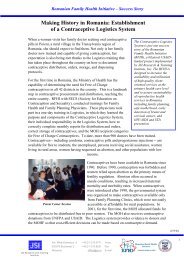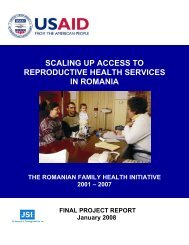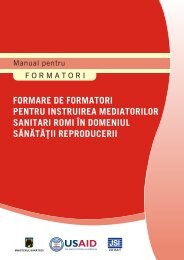Training of Roma Health Mediators in Reproductive Health
Training of Roma Health Mediators in Reproductive Health
Training of Roma Health Mediators in Reproductive Health
Create successful ePaper yourself
Turn your PDF publications into a flip-book with our unique Google optimized e-Paper software.
Expla<strong>in</strong> that the movement <strong>of</strong> the r<strong>in</strong>g could be a little difficult at the beg<strong>in</strong>n<strong>in</strong>g, but <strong>in</strong><br />
time this will be easier.<br />
Distribute participants the Cue-card Standard Days Method (Cycle Beads). Check if they<br />
have any questions and expla<strong>in</strong> that this job-aid will help them to conduct discussion with<br />
clients <strong>in</strong> their communities, us<strong>in</strong>g the draw<strong>in</strong>gs to expla<strong>in</strong> the method.<br />
Summarize:<br />
• CycleBeads are based on a natural family plann<strong>in</strong>g method called the Standard<br />
Days Method (SDM). This method is more than 95% effective when used<br />
correctly.<br />
• A woman can use this method if her cycles last between 26 and 32 days. To use it<br />
effectively, the couple needs to avoid unprotected <strong>in</strong>tercourse on days when the<br />
woman can get pregnant.<br />
II.<br />
EVALUTION OF CLIENTS FOR SDM USING (20 m<strong>in</strong>utes)<br />
Ask participants:<br />
‣ Who can use this method?<br />
Note their answers on the flipchart<br />
Possible answers:<br />
• Women who have the cycles between 26 and 32 days<br />
• Couples who jo<strong>in</strong>tly decided to avoid a pregnancy<br />
• Couples able to avoid <strong>in</strong>tercourse for 12 days (dur<strong>in</strong>g the fertile perioad)<br />
• Couples at no risck for sexually transmited <strong>in</strong>fections<br />
If the list provided with participants’ <strong>in</strong>puts is not <strong>in</strong>clud<strong>in</strong>g all the above criteria, add<br />
them on the list and expla<strong>in</strong> their importance. Emphasize that the method addresses to a<br />
couple and is very important to ask woman questions which will help her to th<strong>in</strong>k about<br />
method appropriateness for her and her partner.<br />
Underl<strong>in</strong>e “cycles between 26 and 32 days” on the list. Rem<strong>in</strong>d participants what<br />
menstrual cycles means.<br />
Demonstrate how one can determ<strong>in</strong>e if the client’s menstrual cycle length is 26 to 32<br />
days, us<strong>in</strong>g a list <strong>of</strong> questions and a calendar:<br />
[Note to the tra<strong>in</strong>er: prepare <strong>in</strong> advance a flipchart with one month calendar with big<br />
figures, visible to all participants]<br />
Ask the follow<strong>in</strong>g questions:<br />
• Do your periods usually come when you expect them?<br />
• When was the first day <strong>of</strong> your most recent period? (note the day <strong>in</strong> the calendar<br />
on the flipchart)<br />
84<br />
RFHI <strong>Tra<strong>in</strong><strong>in</strong>g</strong> <strong>of</strong> RHMs <strong>in</strong> <strong>Reproductive</strong> <strong>Health</strong> Session 5: SDM



